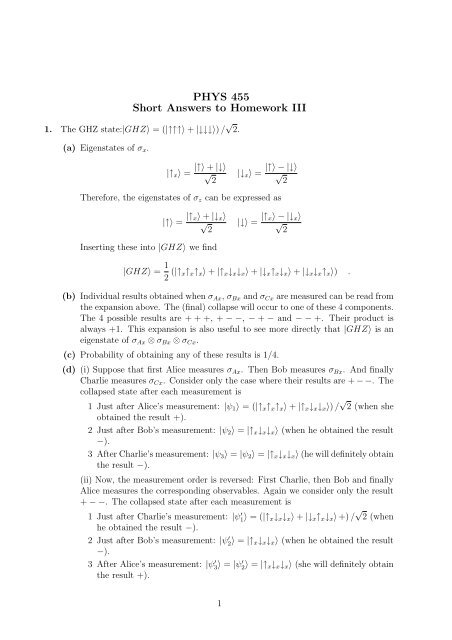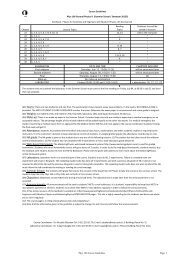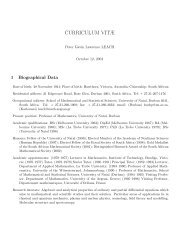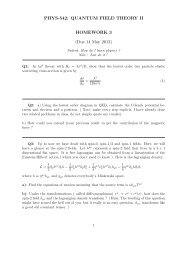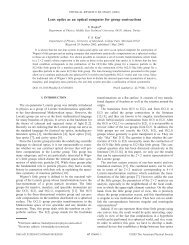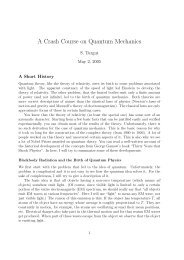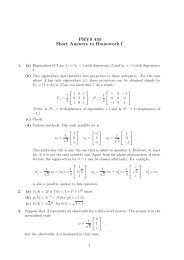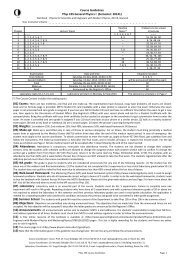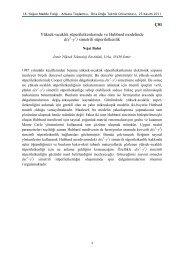PHYS 455 Short Answers to Homework III
PHYS 455 Short Answers to Homework III
PHYS 455 Short Answers to Homework III
- No tags were found...
You also want an ePaper? Increase the reach of your titles
YUMPU automatically turns print PDFs into web optimized ePapers that Google loves.
<strong>PHYS</strong> <strong>455</strong><strong>Short</strong> <strong>Answers</strong> <strong>to</strong> <strong>Homework</strong> <strong>III</strong>1. The GHZ state:|GHZ〉 = (|↑↑↑〉 + |↓↓↓〉) / √ 2.(a) Eigenstates of σ x .|↑ x 〉 =|↑〉 + |↓〉√2|↓ x 〉 =|↑〉 − |↓〉√2Therefore, the eigenstates of σ z can be expressed as|↑〉 = |↑ x〉 + |↓ x 〉√2|↓〉 = |↑ x〉 − |↓ x 〉√2Inserting these in<strong>to</strong> |GHZ〉 we find|GHZ〉 = 1 2 (|↑ x↑ x ↑ x 〉 + |↑ x ↓ x ↓ x 〉 + |↓ x ↑ x ↓ x 〉 + |↓ x ↓ x ↑ x 〉) .(b) Individual results obtained when σ Ax , σ Bx and σ Cx are measured can be read fromthe expansion above. The (final) collapse will occur <strong>to</strong> one of these 4 components.The 4 possible results are + + +, + − −, − + − and − − +. Their product isalways +1. This expansion is also useful <strong>to</strong> see more directly that |GHZ〉 is aneigenstate of σ Ax ⊗ σ Bx ⊗ σ Cx .(c) Probability of obtaining any of these results is 1/4.(d) (i) Suppose that first Alice measures σ Ax . Then Bob measures σ Bx . And finallyCharlie measures σ Cx . Consider only the case where their results are + − −. Thecollapsed state after each measurement is1 Just after Alice’s measurement: |ψ 1 〉 = (|↑ x ↑ x ↑ x 〉 + |↑ x ↓ x ↓ x 〉) / √ 2 (when sheobtained the result +).2 Just after Bob’s measurement: |ψ 2 〉 = |↑ x ↓ x ↓ x 〉 (when he obtained the result−).3 After Charlie’s measurement: |ψ 3 〉 = |ψ 2 〉 = |↑ x ↓ x ↓ x 〉 (he will definitely obtainthe result −).(ii) Now, the measurement order is reversed: First Charlie, then Bob and finallyAlice measures the corresponding observables. Again we consider only the result+ − −. The collapsed state after each measurement is1 Just after Charlie’s measurement: |ψ ′ 1〉 = (|↑ x ↓ x ↓ x 〉 + |↓ x ↑ x ↓ x 〉 +) / √ 2 (whenhe obtained the result −).2 Just after Bob’s measurement: |ψ ′ 2〉 = |↑ x ↓ x ↓ x 〉 (when he obtained the result−).3 After Alice’s measurement: |ψ ′ 3〉 = |ψ ′ 2〉 = |↑ x ↓ x ↓ x 〉 (she will definitely obtainthe result +).1
As a result, the results obtained and the final collapsed state does not depend on theorder which the individual measurements are carried out. The same conclusion willalso be true between the local measurements described here and a single measuremen<strong>to</strong>f these three observables when these three particles are <strong>to</strong>gether.However, the intermediate collapsed states will depend on the order as the exampleabove illustrates. Moreover, the possibilities of different results at the time of theexperiment depends on the order (for this example, the last person doing the measurementgets a definite result depending on the results of previous two measurements).This is why the Cophenagen interpretation is problemmatic for relativity. If Alice,Bob and Charlie are at very distant locations in space and they do their measurementsat more or less same times, then there will be different reference frames (moving withdifferent velocities) such that observers in these frames will see different orders forthese measurements. As a result, different observers will describe the intermediatecollapsed states differently, even though they are describing the same physical events.(However, the final collapsed state, results and their probabilities will be the same forevery observer.)2. (a) Using the matrix representation we haveρ = ∑ p α ψ α ψ α † = 1 [ ] 1 0+ 1 [ ]1 1 1+ 1 13 0 0 3 2 1 1 3 2α[ 1 −ii 1]= 1 [64 1 − i1 + i 2].(b) LetQ + =[ 1 00 0]Q − =[ 0 00 1be the respective projec<strong>to</strong>rs on<strong>to</strong> the spin-up and spin-down states along z axis.ThenP + = tr Q + ρ = tr 1 [ ] 4 0= 2 ,6 0 0 3and similarly for P − = tr Q − ρ = 1/3. These probabilities can be equivalentlycomputed asP + = 〈↑ |ρ| ↑〉 = 2 3]P − = 〈↓ |ρ| ↓〉 = 1 3(c) 〈σ x 〉 = tr σ x ρ = 1/3, etc. We get 〈σ y 〉 = 〈σ z 〉 = 1/3 also. In other words,,.〈⃗σ〉 = ˆx + ŷ + ẑ3.3. (a,b) Show.(c) We find tr ⃗σ · ⃗u = 0 and tr (⃗σ · ⃗u)(⃗σ · ⃗v) = 2⃗u · ⃗v.2
4. ρ is a density matrix for a spin 1/2 particle for which 〈⃗σ〉 = ⃗a.5. (a)(a) 〈σ n 〉 = 〈⃗σ〉 · ˆn = ⃗a · ˆn.(b) Basically we should have −1 ≤ ⃗a · ˆn ≤ 1 for any unit vec<strong>to</strong>r ˆn. This shows thatthe length of ⃗a is at most 1. To show this more elegantly, we choose ˆn = ⃗a/ |⃗a|,i.e., unit vec<strong>to</strong>r parallel <strong>to</strong> ⃗a. In that case, we have ⃗a · ˆn = |⃗a|. The inequalitythen says that |⃗a| ≤ 1.(c) The general expression for a hermitian 2×2 matrix: ρ = c 0 I +c 1 σ x +c 2 σ y +c 3 σ z =c 0 I +⃗c ·⃗σ. Now, using what is known about ρ we get tr ρ = 2c 0 = 1 and thereforec 0 = 1/2. Also, a x = 〈σ x 〉 = tr σ x ρ = 2c 1 etc. gives ⃗c = ⃗a/2. This is the finalexpression for ρI + ⃗a · ⃗σρ = .2In other words, in this two-dimensional space a density matrix ρ is completelydetermined by 〈⃗σ〉, the expectation values of the three Pauli spin matrices. (Tomeasure the density matrix of an ensemble, we just need <strong>to</strong> measure the averageof these three observables.)(e) Let ˆn = ⃗a/ |⃗a|, i.e., same unit vec<strong>to</strong>r used in part (b). In that case, ⃗a · ⃗σ = |⃗a| σ nandρ = I + |⃗a| σ n.2Therefore, the eigenvec<strong>to</strong>rs of ρ are |ˆn ↑〉 and |ˆn ↓〉. The corresponding eigenvaluesare then (1 ± |⃗a|)/2.(f) The density matrix is positive semidefinite means that all of its eigenvalues arenon-negative. This is equivalent <strong>to</strong> |⃗a| ≤ 1 in this case.(g) ρ represents a pure state if ρ has a single eigenvalue equal <strong>to</strong> 1 and the rest of itseigenvalues are 0. This can happen if and only if |⃗a| = 1.ρ A = tr BC |GHZ〉 〈GHZ|1= tr BC (|↑↑↑〉 〈↑↑↑| + |↑↑↑〉 〈↓↓↓| + |↓↓↓〉 〈↑↑↑| + |↓↓↓〉 〈↓↓↓|)21= tr BC (|↑〉 〈↑| ⊗ |↑↑〉 〈↑↑| + |↑〉 〈↓| ⊗ |↑↑〉 〈↓↓|2+ |↓〉 〈↑| ⊗ |↓↓〉 〈↑↑| + |↓〉 〈↓| ⊗ |↓↓〉 〈↓↓|)= 1 (|↑〉 〈↑| 〈↑↑ | ↑↑〉 + |↑〉 〈↓| 〈↓↓ | ↑↑〉2+ |↓〉 〈↑| 〈↑↑ | ↓↓〉 + |↓〉 〈↓| 〈↓↓ | ↓↓〉)= 1 2 (|↑〉 〈↑| + |↓〉 〈↓|) = 1 2 I AAs the |GHZ〉 state is very symmetric among the three particles, the same resultsare obtained for the other two parties, i.e., ρ B = I B /2 and ρ C = I C /2. Here, I Ais the identity opera<strong>to</strong>r for Alice’s particle etc.3
(b) 〈σ Ax 〉 = tr σ Ax ρ A = 0. Similarly 〈σ Bx 〉 = 〈σ Cx 〉 = 0.(c) Call these probabilities as p +++ , p +−− , p −+− and p −−+ . Then, sum of probabilitiesrule and the known expectation values computed above can be written as1 = p +++ + p +−− + p −+− + p −−+ ,〈σ Ax 〉 = 0 = p +++ + p +−− − p −+− − p −−+ ,〈σ Bx 〉 = 0 = p +++ − p +−− + p −+− − p −−+ ,〈σ Cx 〉 = 0 = p +++ − p +−− − p −+− + p −−+ .Solving these we get p +++ = p +−− = p −+− = p −−+ = 1/4.4


